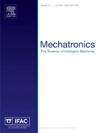Adaptive model-free control for ankle-assistive orthosis: A robust approach to real-time gait tracking
IF 3.1
3区 计算机科学
Q2 AUTOMATION & CONTROL SYSTEMS
引用次数: 0
Abstract
Actuated Ankle-Foot Orthoses (AAFOs) assist dorsiflexion and plantarflexion movements at the ankle joint, supporting mobility and rehabilitation by complementing the wearer’s residual muscular activity within an assist-as-needed paradigm. Their effectiveness depends on advanced control strategies and accurate modeling of the coupled human-AAFO dynamics, which remains a challenging task. This paper presents a novel assist-as-needed control approach for an AAFO/wearer system based on an adaptive model-free framework, without the need for a dynamic model of the AAFO/wearer system. The proposed approach uses an ultra-local model, wherein a intelligent projection-based adaptive PID (iA-PID) controller is designed to achieve satisfactory tracking of a reference ankle joint trajectory. External torques affecting the AAFO/wearer system are estimated using a time-delay estimator and are compensated within the iPA-PID controller to ensure assist-as-needed control. Additionally, the projection operator constrains the evolution of the adaptive parameters, preventing actuator saturation and enabling controlled assistance delivery. Finite-time stability of the resulting closed-loop system is proven, and the final value theorem ensures that the tracking error converges to zero. The performance of the proposed approach is evaluated through simulations and real-time experiments with four healthy subjects. A comparison of tracking performance with several benchmark approaches was conducted as well as robustness tests under varying walking speeds to confirm the effectiveness and reliability of the proposed control approach.
踝关节辅助矫形器的自适应无模型控制:实时步态跟踪的鲁棒方法
驱动式踝足矫形器(AAFOs)辅助踝关节的背屈和跖屈运动,通过补充佩戴者的剩余肌肉活动,在需要的辅助模式下支持活动和康复。它们的有效性取决于先进的控制策略和精确的人- aafo耦合动力学建模,这仍然是一个具有挑战性的任务。本文提出了一种基于自适应无模型框架的AAFO/佩戴者系统的随需辅助控制方法,该方法无需AAFO/佩戴者系统的动态模型。该方法采用超局部模型,设计了基于智能投影的自适应PID (iA-PID)控制器,实现了对参考踝关节轨迹的满意跟踪。影响AAFO/佩戴者系统的外部扭矩使用时滞估计器进行估计,并在iPA-PID控制器内进行补偿,以确保根据需要进行辅助控制。此外,投影算子限制了自适应参数的演变,防止执行器饱和,实现可控的辅助交付。证明了闭环系统的有限时间稳定性,并利用终值定理保证了跟踪误差收敛于零。通过四名健康受试者的仿真和实时实验,对该方法的性能进行了评估。通过与几种基准方法的跟踪性能比较以及不同行走速度下的鲁棒性测试,验证了所提控制方法的有效性和可靠性。
本文章由计算机程序翻译,如有差异,请以英文原文为准。
求助全文
约1分钟内获得全文
求助全文
来源期刊

Mechatronics
工程技术-工程:电子与电气
CiteScore
5.90
自引率
9.10%
发文量
0
审稿时长
109 days
期刊介绍:
Mechatronics is the synergistic combination of precision mechanical engineering, electronic control and systems thinking in the design of products and manufacturing processes. It relates to the design of systems, devices and products aimed at achieving an optimal balance between basic mechanical structure and its overall control. The purpose of this journal is to provide rapid publication of topical papers featuring practical developments in mechatronics. It will cover a wide range of application areas including consumer product design, instrumentation, manufacturing methods, computer integration and process and device control, and will attract a readership from across the industrial and academic research spectrum. Particular importance will be attached to aspects of innovation in mechatronics design philosophy which illustrate the benefits obtainable by an a priori integration of functionality with embedded microprocessor control. A major item will be the design of machines, devices and systems possessing a degree of computer based intelligence. The journal seeks to publish research progress in this field with an emphasis on the applied rather than the theoretical. It will also serve the dual role of bringing greater recognition to this important area of engineering.
 求助内容:
求助内容: 应助结果提醒方式:
应助结果提醒方式:


